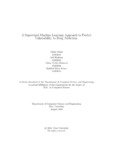| dc.contributor.advisor | Chakrabarty, Amitabha | |
| dc.contributor.author | Faisal, Fahim | |
| dc.contributor.author | Shahriar, Arif | |
| dc.contributor.author | Mahmud, Sohan Uddin | |
| dc.contributor.author | Shuvo, Rakibul Alam | |
| dc.date.accessioned | 2020-02-18T05:43:09Z | |
| dc.date.available | 2020-02-18T05:43:09Z | |
| dc.date.copyright | 2019 | |
| dc.date.issued | 2019-08 | |
| dc.identifier.other | ID 15201001 | |
| dc.identifier.other | ID 15201002 | |
| dc.identifier.other | ID 15201006 | |
| dc.identifier.other | ID 15201025 | |
| dc.identifier.uri | http://hdl.handle.net/10361/13779 | |
| dc.description | This thesis is submitted in partial fulfillment of the requirements for the degree of Bachelor of Science in Computer Science, 2019. | en_US |
| dc.description | Cataloged from PDF version of thesis. | |
| dc.description | Includes bibliographical references (pages 72-74). | |
| dc.description.abstract | There are signi cant amount of di erences between an addicted and non-addicted
person on their social and familial behavior. In our thesis we tried to nd out
the characteristics of a person related to his social and familial life and also health
issues that can prove his vulnerability to drug addiction. The research was held
on the context of the people of Dhaka, Bangladesh and on an age group of 15 to
40 years. A primary data set was constructed which include 498 samples. For
constructing the questionnaire Addiction Severity Index and WHO's Assist Scale
were followed along with the help of psychologists and specialists on drug addiction.
For addicted person's data we reached some rehabilitation center of Dhaka and for
non-addicted person's data we communicated di erent aged group people of di erent
colleges and universities. 498 samples where one sample consisted of 60 features
were trained and tested by supervised machine learning approach. Reliability of
the data set was validated by Cronbach's Alpha Nominal Test. 10 algorithms were
incorporated including Neural Network, Deep Belief Network, Random Forest, XGBooster
etc. and their results were compared. Among the algorithms, XGB came
up with the highest number of accuracy of 95.20% and KNN delivered the least
which is 88.97%. In order to select important features mRMR, Chi-square, Principle
Component Analysis techniques were used. From feature selection we got the key
features of an addicted person's behavior that were in
uential for their drug abuse.
This will help people to understand if a person is going to be vulnerable to addiction
or not based on their health issues and social and familial behavior. | en_US |
| dc.description.statementofresponsibility | Fahim Faisal | |
| dc.description.statementofresponsibility | Arif Shahriar | |
| dc.description.statementofresponsibility | Sohan Uddin Mahmud | |
| dc.description.statementofresponsibility | Rakibul Alam Shuvo | |
| dc.format.extent | 83 pages | |
| dc.language.iso | en | en_US |
| dc.publisher | Brac University | en_US |
| dc.rights | Brac University theses are protected by copyright. They may be viewed from this source for any purpose, but reproduction or distribution in any format is prohibited without written permission. | |
| dc.subject | Primary data | en_US |
| dc.subject | mRMR | en_US |
| dc.subject | Deep beilief nerwork | en_US |
| dc.subject | Reliability | en_US |
| dc.subject | Vulnerability to addiction | en_US |
| dc.subject | Neural network | en_US |
| dc.subject | Random forest | en_US |
| dc.subject.lcsh | Neural networks (Computer science) | |
| dc.subject.lcsh | Machine learning | |
| dc.title | A supervised machine learning approach to predict vulnerability to drug addiction | en_US |
| dc.type | Thesis | en_US |
| dc.contributor.department | Department of Computer Science and Engineering, Brac University | |
| dc.description.degree | B. Computer Science | |

